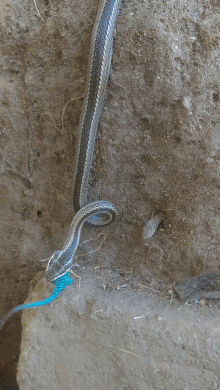Philodryas chamissonis
Philodryas chamissonis, commonly known as the long-tailed snake, is a species of moderately venomous opisthoglyphous (rear-fanged) snake in the family Colubridae. The species is native to South America.[4]
| Philodryas chamissonis | |
|---|---|
 | |
| Scientific classification | |
| Kingdom: | Animalia |
| Phylum: | Chordata |
| Class: | Reptilia |
| Order: | Squamata |
| Suborder: | Serpentes |
| Family: | Colubridae |
| Genus: | Philodryas |
| Species: | P. chamissonis |
| Binomial name | |
| Philodryas chamissonis (Wiegmann, 1834) | |
| Synonyms | |
Etymology
The specific name, chamissonis, is in honor of German botanist and poet Adelbert von Chamisso.[2][5]
Geographic range
P. chamissonis is endemic to Chile and has a large distribution, from Copiapó to Valdivia.
Description
Usually, P. chamissonis is gray, with black and white longitudinal stripes on the body. It is a medium-sized snake, which usually reaches 1.4 m (4.6 ft) in total length (including tail).
The length of the tail is 25-28.5 % of the total length. There are 8 upper labials, the 4th and 5th entering the eye. The smooth dorsal scales are arranged in 19 rows at midbody. Ventrals 179-225; anal plate divided; subcaudals 100-122.[6]
Habitat
Philodryas chamissonis lives in a large variety of habitats.
Diet

The diet of P. chamissonis is mainly composed of little rodents, insects, and other smaller reptiles.
Reproduction
P. chamissonis is an oviparous reptile.
Venom
Because P. chamissonis is rarely found, bites by it are uncommon. However, its bite is painful and causes extensive swelling.[7]
References
- Avilés R, Garin C, Nunez J, Ortiz JC, Sallaberry N, Tala C, Victoriano P, Vidal M (2016). "Philodryas chamissonis". The IUCN Red List of Threatened Species. IUCN. 2016: e.T16985A69941244. doi:10.2305/IUCN.UK.2016-1.RLTS.T16985A69941244.en. Retrieved 15 January 2018.
- "Philodryas chamissonis ". The Reptile Database. www.reptile-database.org.
- Sallaberry-Pincheira N, Garin CF, González-Acuña D, Sallaberry MA, Vianna JA (2011). "Genetic Divergence of Chilean long-tailed snake (Philodryas chamissonis) across latitudes: conservation threats for different lineages". Diversity and Distribution 17: 152-162.
- "Philodryas chamissonis ". ITIS (Integrated Taxonomic Information System). www.itis.gov.
- Beolens, Bo; Watkins, Michael; Grayson, Michael (2011). The Eponym Dictionary of Reptiles. Baltimore: Johns Hopkins University Press. xiii + 296 pp. ISBN 978-1-4214-0135-5. (Philodryas chamissonis, p. 51).
- Boulenger GA (1894). Catalogue of the Snakes in the British Museum (Natural History). Volume II., Containing the Conclusion of the Colubridæ Aglyphæ. London: Trustees of the British Museum (Natural History). (Taylor and Francis, printers). xi + 382 pp. + Plates I-XX. (Dromicus chamissonis, pp. 119-120).
- Neira P, Jofré L, Oschilewski D, Subercaseaux B, Muñoz N (2007). "Mordedura por Philodryas chamissonis. Presentación de un caso y revisión de la literatura (Snake bite by Philodryas chamissonis: a case presentation and literature review)". Revista chilena de infectología 24 (3): 236-241. (in Spanish).
Further reading
- Freiberg M (1982). Snakes of South America. Hong Kong: T.F.H. Publications. 189 pp. ISBN 0-87666-912-7. (Dromicus chamissonis, p. 95).
- Wiegmann AFA (1835). "Beiträge zur Zoologie, Gesammelt auf einer Reise um die Erde. Siebente Abhandlung. Amphibien ". Nova Acta Physico-Medica Academiae Caesareae Leopoldino-Carolinae Naturae Curiosorum (Wrocław and Bonn) 17: 185-268 + Plates XIII-XXII. (Coronella chamissonis, new species, pp. 246–250 + Plate XIX). (in German and Latin).
